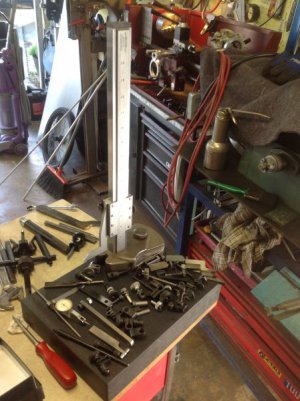- Joined
- Jul 2, 2014
- Messages
- 7,594
I am not afraid of leaving, just not in any big hurry...The way I figure it, Bob, as long as we're on this side of the dirt, its all good!
I am not afraid of leaving, just not in any big hurry...The way I figure it, Bob, as long as we're on this side of the dirt, its all good!


He said, "Because you do custom work for free!"
Damned kids have an answer for everything. I need to slap that boy!
No need for money, favor for favor. You do the machine work while the son works in the yard or garden (or whatever.) "Sweat equity."No need to slap him, just charge him.
Yes. Any used tool purchase needs to be vetted to see if it is correct, and corrected if it is not. New ones should be, too, and are in industry.The inch wasn't standardized until 1933, Starrett goes back to the 1870s, so while the precision may be there, it is possible for very old tools to read differently than more modern ones.
Trouble with tech and pricing of analog tools are related in an odd way. Those who appreciate form, fit and function gravitate to [or at least don't avoid] verniers, transfer tools, hand ground bits etc...With downfall of vocational training in education, what were basics have changed, so tools that took interpretation have weird names, look weird, and lack familiar controls. Auction sites attract all levels of craft skills, but population tells you the older ages compose a lesser percentage and possibly have a lot of tools. And some guy has a Starrett Master height gauge listed 12 months with no action. I have Starrett Master height and outside calipers collected over the years; admire the design, close to infallible, they make me money, and might be among best ever made. No batteries, no rack to collect chips, easy to verify zero.Funny how old tech makes us old guys feel dated. My only vernier is my Starrett 14" Master Bar height gage. When I realized I couldn't get by anymore without a height gage I started trolling eBay and was shocked to find high end vernier's were dirt cheap compared to digital and dial. At that time there were several vernier just sitting and the choice was how big and how many accessories were included. I ended up paying $120 + shipping (I think $30?) for the gage plus all the adapters and snugs. And thrown in as a freebie was a B&S BestTest DTI! Some of the accessories like the depth gage are are expensive as is the height gage if you were to buy it new. This was obviously used everyday but taken care of. What blows me away is no matter how many snugs and adapters I accumulate I still get stumped and don't have some odd size to do something.
